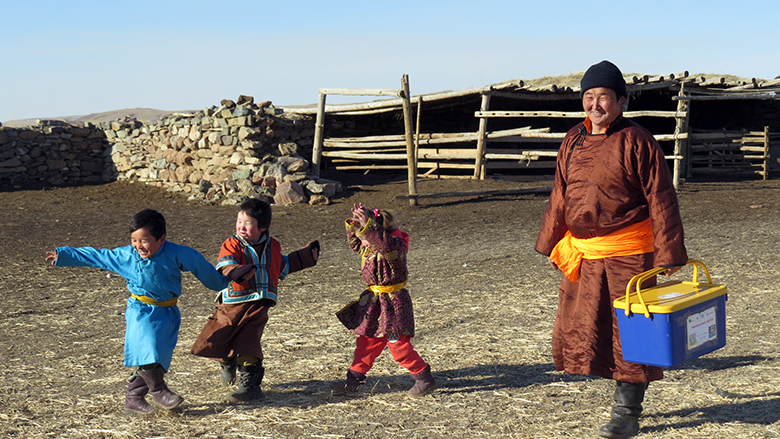Challenge
Mongolia offers free compulsory primary education to all children starting from age six. Yet, a significant part of the population faces challenges in actually accessing quality primary education.
Nomadic herder families represent nearly 30 percent of the country’s total population of 3 million. These families move several times a year in search of better pasture for their livestock. They are faced with a hard decision when it comes to sending their children to school – splitting up the family or delaying education for their children.
Young children in rural areas would need to go to a boarding school or stay with their relatives living in soum (village) center, but for a child, being separated from family at such a young age presents significant socio-emotional distress. Or a mother could migrate to a soum center with her child, leaving the father behind to herd animals. Or the family may choose to delay school enrolment.
Most rural children enroll in school without adequate preschool preparation, which often means they encounter learning difficulties in school. Recreational and development activities at dormitories were scarce. In addition, non-formal education programs for children start from age 10, leaving the educational needs of lower-primary grade children unmet. Eighty percent of school dropout cases of children aged 6 -14 occurred in rural areas, with the majority of those in primary grades.
Approach
Recognizing the crucial role of quality early education and the smooth adjustment to school/dormitory life in the children’s overall development, a unique project was developed to support the education needs of the children in remote rural communities. The project, financed by the Japan Social Development Fund, was developed in close consultation with local herders, parents, teachers, and education authorities, and introduced several innovative programs to improve education services at the local level, and to mobilize parents and community members.
Results
Getting ready for school
The home-based school preparation program helps 5-year-old children living in the most remote rural areas with limited or no access to early childhood education get ready for school. Children learn by using a specially designed home-based school preparation learning program and selected educational toys and materials at home. Parents are the primary teachers here, engaging with their children every day through reading, singing, and playing together. They are trained by local teachers and also have their own guide books.
Parents borrow the learning materials from the mobile toy and book library established in 30 soums as part of the program. There are 30+ educational kits in the library, with different sets of educational and story books, toys, digital tools and listening resources. Parents and children use each educational kit for about 2-3 weeks and then get another one.
So far, the program has helped 3,900 children in target soums prepare for school. The 2,100 children who completed the program have successfully enrolled into primary school in the 2013-2016 academic years and another 1,800 will enroll this fall.
A recent study on early childhood education in Mongolia found that cognitive and non-cognitive skills of the children enrolled in the program were significantly higher compared to those enrolled in existing alternative education programs, underlining the potential for a home-based model to improve school readiness among hard-to-reach populations.
After-school time full of fun and learning
To help children adapt to dormitory environment and spend time productively after school, child development centers were established in 30 school dormitories offering a variety of extra-curricular activities for rural children.
The after-school program includes a total of 100 different teaching methodologies combining academic, recreational, cultural and development activities to enrich children’s school life.
As of June 2017, the program reached around 4,400 6- to 10-year-olds.
Compensatory Education Program
Lower-primary grade children in rural areas who dropped out or never attended school before now have a chance to get back on track and continue their education along with their peers.
Many of those who dropped out happen to be disabled, homebound, and or not eligible to enroll in non-formal classes due to their young age.
Six types of compensatory education programs were developed to help these children catch up with grade 1, 2 and 3 learning.
The program enables the children to study at home with their parents’ support and with some remote guidance from the local life-long learning centers.
Around 200 children, including 80 children under age 10 have benefitted, and many of them have been able to successfully enroll in corresponding grades.
In addition to rural children, the programs are accessible online for Mongolian children living abroad, who need to learn their native language.
Community Education Council
Community Education Councils were established in each of the 30 soums with voluntary participation of parents, teachers and local government officials to help organize and mobilize the community around children’s education and development.
The councils have evolved to become one of the most active community units in rural areas, supporting families and children, and strengthening collaboration among parents, schools and local government in their communities.
The project also provided some of these community initiatives with small-scale, results-based grants to encourage innovation and creativity.
So far, 138 community projects were successfully implemented with small-grant funding and further support from the soum government budget or other resources, reaching around 8,600 children.
